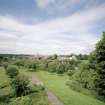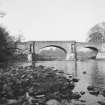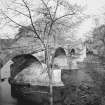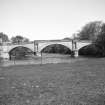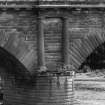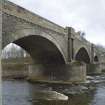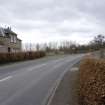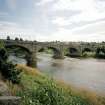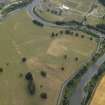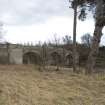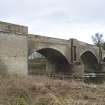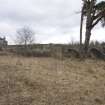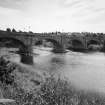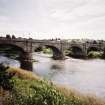Kelso, Teviot Bridge
Road Bridge (Period Unassigned)
Site Name Kelso, Teviot Bridge
Classification Road Bridge (Period Unassigned)
Alternative Name(s) River Teviot; Teviot Bridge, Kelso; Springwood Park
Canmore ID 77552
Site Number NT73SW 79
NGR NT 71984 33547
Datum OSGB36 - NGR
Permalink http://canmore.org.uk/site/77552
- Council Scottish Borders, The
- Parish Kelso
- Former Region Borders
- Former District Roxburgh
- Former County Roxburghshire
In 1795, a bridge over the River Teviot was built by William Elliot, although the design used appears to have been drawn up by another architect or builder, Alexander Stevens.
Teviot Bridge has three arches, with pedestrian 'refuges' or passing places above the pillars supporting the central and largest span. Each of the bridge's piers stands on a wedge-shaped cut water designed to break the current of the river.
Alexander Stevens submitted his first design for the bridge in 1784, with a budget of #1,000 which was raised to #1,230 in 1788. It appears that this offer was still being considered in 1792 when work began on the bridge.
Text prepared by RCAHMS as part of the Accessing Scotland's Past project
NT73SW 79 71984 33547
Teviot Bridge [NAT]
OS 1:10,000 map, 1993.
Not to be be confused with Kelso Bridge (over the River Tweed), for which see NT73SW 64.01.
(Location cited as NT 720 336). Teviot Bridge, early 19th century. A 3-span bridge, with a large segmental arch flanked by single, slightly smaller, arches with carriageways sloping up to the centre of the bridge. There are pointed cutwaters supporting pairs of pilasters, which in turn carry pedestrian refuges.
J R Hume 1976.
Teviot Bridge, 1795, William Elliot. Possibly the brother of Archibald and James Elliot from Ancrum, William was certainly the builder, although the designer of this elegant bridge could well have been Alexander Stevens, who submitted a design and price (£1000) first in 1784, updating it to £1230 in 1788. The principal features of the bridge are engaged Doric columns, as previously used by Robert Mylne (Blackfriars Bridge, London, 1760-9), Harrison (at Lancaster's Skerton Bridge, 1783-8) and subsequently by Rennie downstream at Kelso (1800-3) and at waterloo [London], in 1811-17. Like the majority of bridge structures, it is best viewed from river level, where one can appreciate its fine proportions.
C A Strang 1994.
This bridge carries the A699 public road over the River Teviot to the SW of the modern town of Kelso (NT73SW 44) and at the W extremity of Springwood Park. The river here forms the boundary between the modern parishes of Kelso (to the N) and Roxburgh (to the S).
The location assigned to this recoird defines the centre of the span. The available map evidence indicates that it extends from NT c. 71974 33573 to NT c. 72003 33511.
Information from RCAHMS (RJCM), 31 January 2006.
Photographic Survey (1955)
Photographic survey by the Scottish National Buildings Record in 1955.
Project (2007)
This project was undertaken to input site information listed in 'Civil engineering heritage: Scotland - Lowlands and Borders' by R Paxton and J Shipway, 2007.
Publication Account (2007)
Alexander Stevens submitted designs and estimates for this bridge in 1784 and 1788 and although the actual
builder in 1794–95 was William Elliot of Kelso, the form and ornament suggest very strongly that it was built to
Stevens’ design. It has some points of similarity with his Bridge of Dun design. The twin columns over each pier, which are ornamental and without structural significance, were first introduced by Robert Mylne at Blackfriars Bridge, London, in 1760–69 and gave rise to the mocking rhyme: ‘I stand, I stand, twin column dear,
But tell me now, – what do we here?’ John Rennie, when visiting Kelso in 1798, was critical of
the architecture of Teviot Bridge and of its position at a river bend. However, he seemed to have second thoughts about twin columns as he incorporated them with a more generous entablature into Kelso Bridge and Waterloo Bridge, London. Teviot Bridge is founded on rock and its arches are segmental with a centre span of 64 ft and side spans of53 ft. The clear width between parapets is 21 ft 6 in. The cutwaters are both curved and pointed like those of the Drygrange Bridge. The cost of construction was about £2000.
R Paxton and J Shipway 2007
Reproduced from 'Civil Engineering Scotland: Lowlands and Borders' with kind permission fromThomas Telford Publishers.
Sbc Note (15 April 2016)
Visibility: Standing structure or monument.
Information from Scottish Borders Council



























